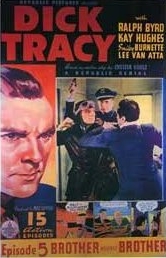Dick Tracy (serial)
| Dick Tracy | |
|---|---|
 |
|
| Directed by |
Alan James Ray Taylor |
| Produced by |
Nat Levine J. Laurence Wickland (Associate) |
| Written by |
Morgan B. Cox George Morgan Barry Shipman Winston Miller Chester Gould (comic strip) |
| Starring |
Ralph Byrd Kay Hughes Smiley Burnette Lee Van Atta John Picorri Robert E. Marcato Carleton Young Fred Hamilton |
| Music by | Harry Grey |
| Cinematography |
William Nobles Edgar Lyons |
| Edited by |
Helene Turner Edward Todd William Witney |
| Distributed by | Republic Pictures |
|
Release date
|
|
|
Running time
|
15 chapters / 290 minutes (serial) 73 minutes (feature) |
| Country | United States |
| Language | English |
| Budget | $112,334 (negative cost: $127,640) |
Dick Tracy (1937) is a 15-Chapter Republic movie serial starring Ralph Byrd based on the Dick Tracy comic strip by Chester Gould. It was directed by Alan James and Ray Taylor.
Dick Tracy's foe for this serial is the crime boss and Masked Mystery Villain The Spider/The Lame One (both names are used) and his Spider Ring. In the process of various crimes, including using his Flying wing and sound weapon to destroy the Bay Bridge in San Francisco and stealing an experimental "Speed Plane", the Spider captures Dick Tracy's brother, Gordon. The Spider's minion, Dr. Moloch, performs a brain operation on Gordon Tracy to turn him evil, making him secretly part of the Spider Ring and so turning brother against brother.
The above cast members appear in the opening credits in "cameo" display - sequential pictures of each actor with his/her name (and sometimes character name) superimposed at the bottom of the screen - for the first episode, followed by a listing of supporting players. Subsequent chapters simply listed the stars on one screen and the same supporting cast a second. This approach to cast display was used by Republic from its first serial through Haunted Harbor in 1944. Universal serials presented a similar approach to cast display until 1940, only in their case, the star-cameos appeared with the first 3-4 episodes, and subsequent episodes listed these names usually followed, on a scrolling cast list, by part, but not often all, of the supporting players who had been named on the episodes with the cameos. Occasionally, a new player or two might be added. Columbia only a few times adopted this approach to displaying the cast of its serials. Republic, Universal, Warner Bros. Pictures, and some independents also used star "cameos" in numbers of their b-pictures during the 1930s.
...
Wikipedia
